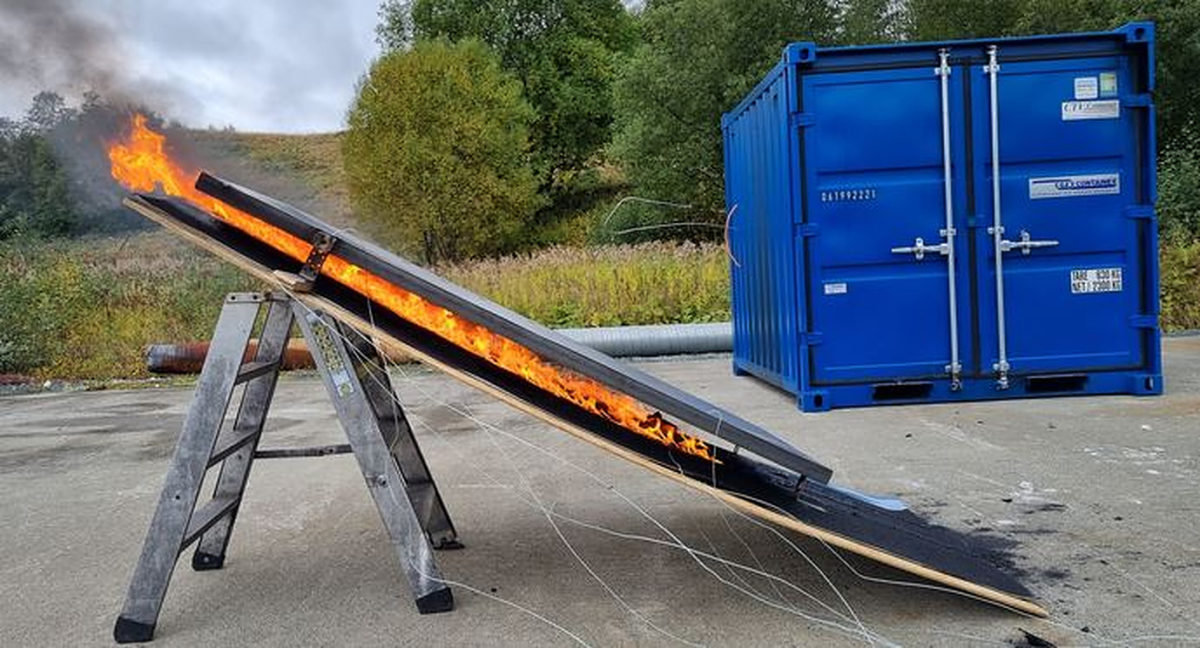From pv magazine Global
Rise Fire Research, an institute in Norway, has conducted a series of experiments indicating that the distance between solar modules and rooftop surfaces could be a crucial factor in PV system fires.
“We have not found any single ideal distance between the roof and the PV modules that can prevent fire propagation,” researcher Ragni Fjellgaard Mikalsen told pv magazine. “But we have seen that the gap distance is one of several parameters that affect the fire spread.”
The scientists said that wind speed and air gap size could affect the development of fires in the space between solar modules and the underlying roof structures. They also looked at how fires could affect PV systems on real, pitched rooftops in Norway. They performed 29 experiments at the institute’s facility in Trondheim in 2021.
The research group identified a link between the size of the gap between a rooftop surface and the modules, and determined how big an initial fire would have to be for the blaze to spread and become larger.
“These, and other experiments, point to that a larger gap distance decreases the flame propagation, but other parameters, like inclination, ignition source, combustible materials can also affect the fire dynamics in the air gap,” Fjellgaard Mikalsen said.
Fjellgaard Mikalsen claimed that there are no testing methods or standards that properly consider the interplay between PV modules and building surfaces.
“The test methods for building materials are not including the possibility to add PV modules, and the test methods for PV modules are not considering what building surface they should be installed on,” she said. “For building integrated PV modules, the modules need to comply with both the regulations for building materials and as an electrical installation.”
Fjellgaard Mikalsen said the modules were tested against one of the four European test methods listed in CEN/TS 1187, but noted that these test methods are not particularly well suited to test PV modules.
“The American test standard UL 1703 / UL 61730 includes some fire tests where the combination of roofing material and PV installation is handled,” she said. “These are based on the test for roofing materials UL 790 where the roof is exposed to an external flame.”
The scientists said that future standards for Norwegian PV installations should be harmonised on a European level, and preferably globally.
“Ideally, the test standards should consider the interactions between the building surface and the PV modules and test the systems at a sufficiently large scale to include the important details of the building surface, fixing system and PV modules,” Fjellgaard Mikalsen said. “To be able to document the fire performance of different combinations of roofing materials, fixing systems and PV modules, a structured classification scheme could be developed.
A similar study, published by the University of Edinburgh and the Technical University of Denmark, showed similar results. The scientists analysed fire dynamics and flame spread on the substrate beneath panels. They concluded that the shorter the distance between the panels and rooftop, the higher the probability of larger and more destructive fires.
This content is protected by copyright and may not be reused. If you want to cooperate with us and would like to reuse some of our content, please contact: editors@pv-magazine.com.









By submitting this form you agree to pv magazine using your data for the purposes of publishing your comment.
Your personal data will only be disclosed or otherwise transmitted to third parties for the purposes of spam filtering or if this is necessary for technical maintenance of the website. Any other transfer to third parties will not take place unless this is justified on the basis of applicable data protection regulations or if pv magazine is legally obliged to do so.
You may revoke this consent at any time with effect for the future, in which case your personal data will be deleted immediately. Otherwise, your data will be deleted if pv magazine has processed your request or the purpose of data storage is fulfilled.
Further information on data privacy can be found in our Data Protection Policy.